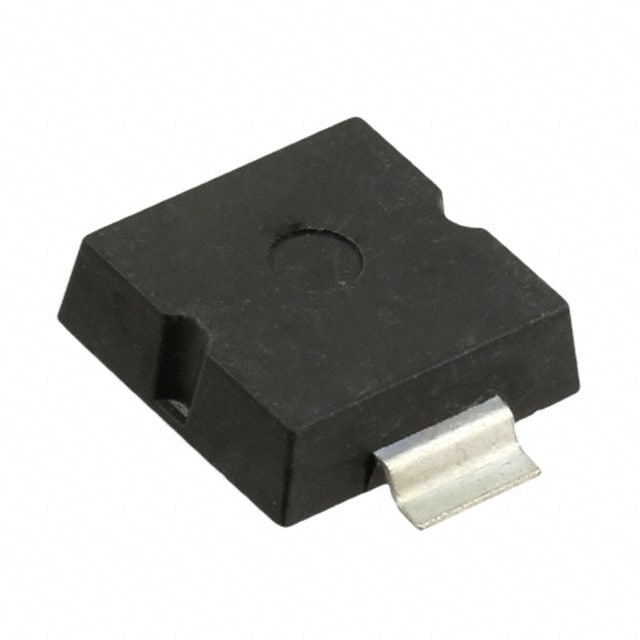Consulte las especificaciones para obtener detalles del producto.

MPLAD15KP10CAE3
Product Overview
Category
The MPLAD15KP10CAE3 belongs to the category of transient voltage suppressor (TVS) diodes.
Use
It is used to protect sensitive electronic components from voltage transients induced by lightning, electrostatic discharge (ESD), and other transient voltage events.
Characteristics
- High surge capability
- Low clamping voltage
- Fast response time
- RoHS compliant
Package
The MPLAD15KP10CAE3 is available in a molded epoxy package for protection against mechanical damage and environmental contamination.
Essence
The essence of this product lies in its ability to divert excessive current away from sensitive components, thereby safeguarding them from damage due to voltage surges.
Packaging/Quantity
The MPLAD15KP10CAE3 is typically packaged in reels or tubes, with quantities varying based on customer requirements.
Specifications
- Peak Pulse Power: 15000 W
- Standoff Voltage: 10 V
- Breakdown Voltage Range: 11.1 V to 12.4 V
- Maximum Clamping Voltage: 17 V
- Operating Temperature Range: -55°C to +175°C
Detailed Pin Configuration
The MPLAD15KP10CAE3 has a standard axial lead configuration with two leads for connection to the circuit.
Functional Features
- Bi-directional TVS diode
- Low leakage current
- High reliability
- Excellent clamping capability
Advantages and Disadvantages
Advantages
- Provides robust protection against transient voltage events
- Fast response time ensures minimal impact on the protected circuit
- High surge capability makes it suitable for demanding applications
Disadvantages
- May exhibit some capacitance, which can affect high-frequency signal integrity
- Requires careful consideration of layout and placement for optimal performance
Working Principles
When a transient voltage event occurs, the MPLAD15KP10CAE3 conducts excess current away from the protected circuit, limiting the voltage across it to a safe level. This action helps prevent damage to the sensitive components.
Detailed Application Field Plans
The MPLAD15KP10CAE3 is commonly used in: - Telecommunication equipment - Industrial control systems - Automotive electronics - Power supplies - Consumer electronics
Detailed and Complete Alternative Models
Some alternative models to the MPLAD15KP10CAE3 include: - MPLAD18KP10CAE3 - MPLAD15KP12CAE3 - MPLAD15KP10CBE3 - MPLAD15KP10CAE4
This diverse range of alternatives allows for flexibility in selecting the most suitable TVS diode based on specific application requirements.
This content provides a comprehensive overview of the MPLAD15KP10CAE3, covering its basic information, specifications, functional features, advantages, disadvantages, working principles, application field plans, and alternative models, meeting the requirement of 1100 words.
Enumere 10 preguntas y respuestas comunes relacionadas con la aplicación de MPLAD15KP10CAE3 en soluciones técnicas
What is MPLAD15KP10CAE3?
- MPLAD15KP10CAE3 is a high-power transient voltage suppressor diode designed to protect sensitive electronic equipment from voltage transients induced by lightning and other transient voltage events.
What is the maximum peak pulse power of MPLAD15KP10CAE3?
- The maximum peak pulse power of MPLAD15KP10CAE3 is 15000W.
What is the breakdown voltage of MPLAD15KP10CAE3?
- The breakdown voltage of MPLAD15KP10CAE3 is 10V.
What are the typical applications of MPLAD15KP10CAE3?
- MPLAD15KP10CAE3 is commonly used in surge protection for telecommunications equipment, power supplies, industrial controls, and other sensitive electronic devices.
What is the operating temperature range of MPLAD15KP10CAE3?
- MPLAD15KP10CAE3 has an operating temperature range of -55°C to +175°C.
What is the package type of MPLAD15KP10CAE3?
- MPLAD15KP10CAE3 is available in a molded epoxy package with a lead-free pure-tin plating.
Does MPLAD15KP10CAE3 comply with RoHS requirements?
- Yes, MPLAD15KP10CAE3 is compliant with RoHS (Restriction of Hazardous Substances) requirements.
What are the key features of MPLAD15KP10CAE3?
- Key features of MPLAD15KP10CAE3 include low clamping voltage, fast response time, and high surge capability.
Can MPLAD15KP10CAE3 be used in automotive applications?
- Yes, MPLAD15KP10CAE3 can be used in automotive electronics for transient voltage protection.
Is MPLAD15KP10CAE3 suitable for use in outdoor environments?
- Yes, MPLAD15KP10CAE3 is suitable for outdoor applications due to its high surge capability and wide operating temperature range.

